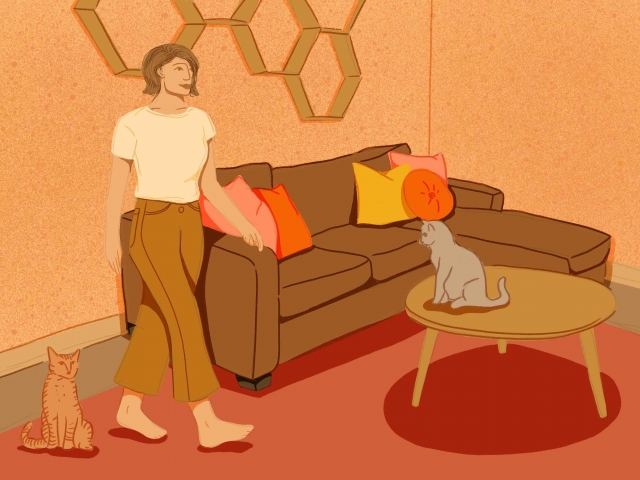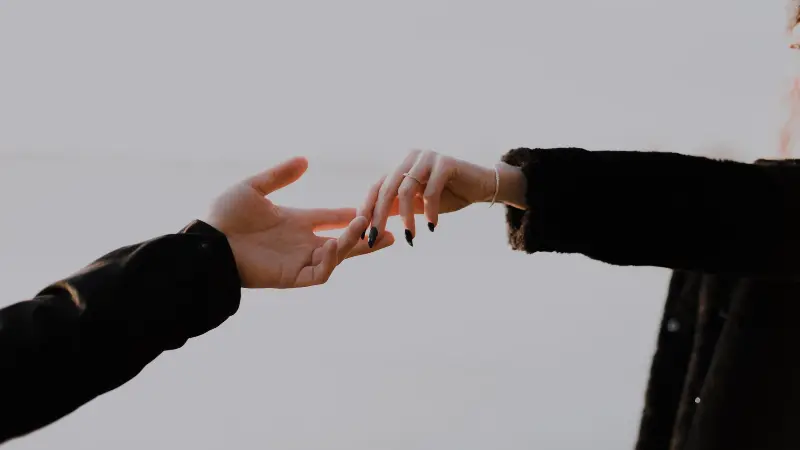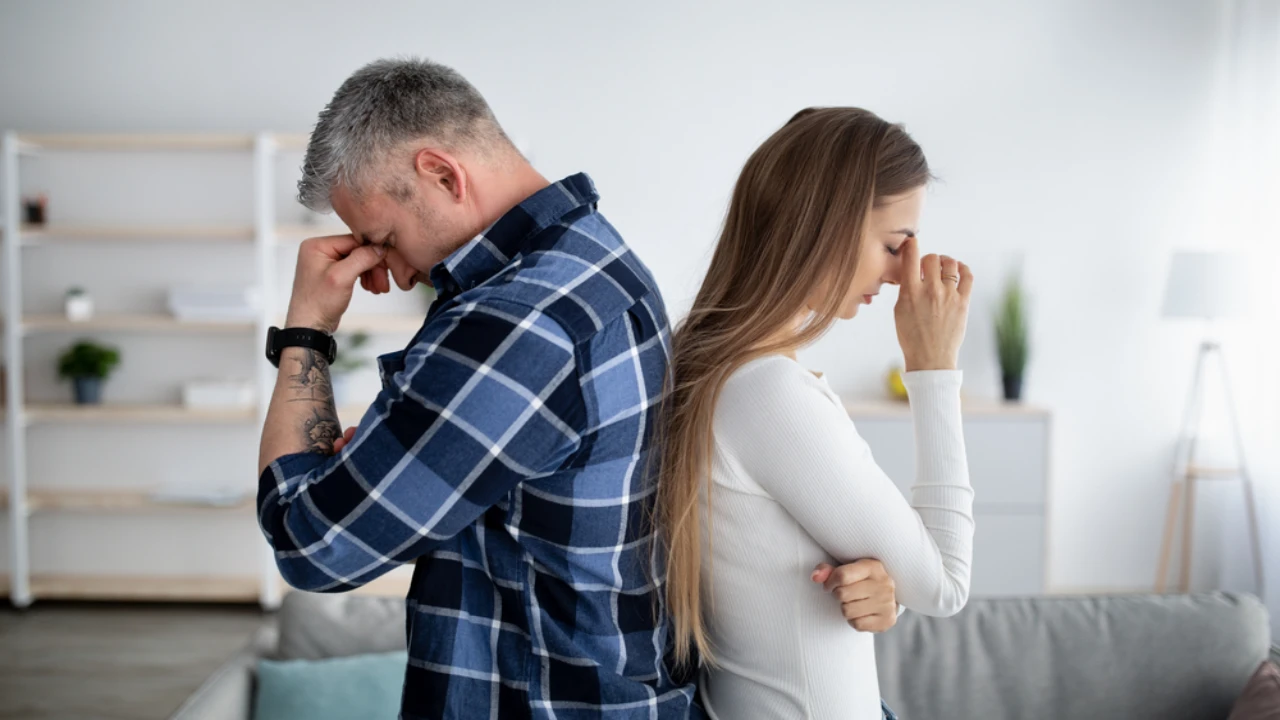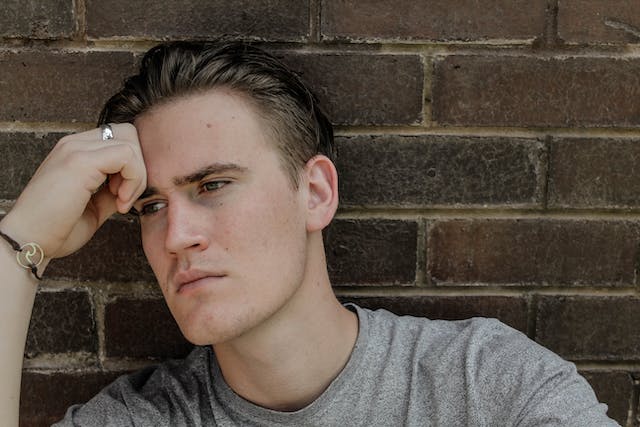Happiness
Episode 60: Step Away from Anxiety

RAINA TELGEMEIER I started having panic attacks and anxiety when I was nine years old. They were confusing. They were isolating. They were terrifying. And they came out of nowhere. And I think the problem with panic attacks is that a lot of times the thing you’re scared about is irrational. So there’s no rhyme or reason for it. So anybody from the outside will see you reacting to this stimuli and they’ll say, “Well, it’s not that big of a deal. Just just calm down.” You know, and and when you’re in the middle of a panic attack, it’s just not possible. So I’ve been dealing with emetophobia, which is the fear of vomit since I was a kid. And it’s followed me through my entire life. And I have spent a lot of time just avoiding situations where I might encounter it. And that looks really different when you’re nine years old than it does when you’re in your 30s. You know, I don’t have kids because I’m scared of people throwing up. That is the reason I don’t have kids. It’s the reason I didn’t want to be pregnant. It’s like there are so many things in my life that are kind of tied to this fear. And in my late thirties, it was finally time for me to just start tackling and to to get over this, because I knew how much it was limiting my life and how it was keeping me from just like going out of my house and interacting with people. I started to be able to contextualize the fear and see it as a chapter in a story right about my life.
DACHER KELTNER Raina Telgemeier has chronicled her fears and anxieties in a series of New York Times bestselling graphic novels for adolescents, all based on her childhood: Smile, Sisters and most recently, Guts, which delves deep into the phobias she has struggled with since she was a kid. Raina has also adapted and illustrated graphic novel versions of Anne M. Martin’s Baby-Sitters Club series. Her books have received many awards, including multiple Eisner Awards, a Boston Globe-Horn Book Honor and a Stonewall Honor.
We asked Raina to try a science tested practice to increase happiness and hopefully reduce anxiety in her own life, and she joins us to share how it went.
Raina, thanks for coming in studio today and joining us on The Science of Happiness.
RAINA TELGEMEIER It’s my pleasure. Thanks for having me.
DACHER KELTNER: Raina, I have to say, reading your newest graphic novel, Guts, was a remarkable experience. It starts out with a young Raina having a stomach ache, and that leads to this exploration of the anxieties kids deal with both internally, in the patterns of thoughts in their mind, with their bodies going through developmental changes, and also externally in their relations to their families and peers.
My own family has a history of anxiety and I struggled with it myself when I was in junior high. It affected my eating, my sleep…In hindsight, after writing and illustrating this chapter of your life, what would you tell a 12 year old, 11 year old, even a 10 year old who is experiencing anxiety? What would you say?
RAINA TELGEMEIER I think what I wish I had known was that it was okay to talk about it. Yeah, for a long time it was something that I was ashamed of, that I hid from people, and didn’t want to tell people that I was going to therapy as a kid. But once I started to open up about it, which I did in middle school and high school, you know, let, like, my closest friends know that it was something that I was dealing with and they would all, you know, help protect me as best as they could. So not just your friends, but your family members and adults in your life. Like, who can you reach out to? Who can you talk to you about this? And I mean, I’ve had kids just in the last couple of months, I’ve already gotten so many letters from kids saying, “Wow, I see myself in your book. I’ve never seen myself represented this way. And I’m going to. I’m going to talk to somebody. I’m going to tell people what I’m going through, I might ask my parents if it’s okay to see a therapist.” Like the fact that a kid would ask to see a therapist just it warms my heart. Yeah. I would never have considered that.
So all of that isolation that I felt as a young person. Now I know that I’m not alone and that when you do share yourself and your feelings, then other people will return. They’ll return compassion, but they’ll also return their own stories. So it becomes this wonderful cycle of sharing
DACHER KELTNER: You had an interesting early life experience which you made into the graphic novel, ‘Smile.’ You know, a lot of people, including my own lab, have done a lot of research on the smile, and what we’ve learned from that is that this simple expressive behavior, the smile, is deeply evolved, and it triggers goodwill in others. Even when we’ve been exposed to a smile that’s been presented so fast we don’t even know what we’ve seen. A smile’s kind of a sign that says, “Hey, let’s affliate, let’s cooperate, let’s be friends.” How did you come to focus on the smile in your writing?
RAINA TELGEMEIER I had a dental accident when I was 11 years old. I tripped, fell and knocked out my two front permanent teeth. And, you know, the beginning of middle school is not really an easy time for any kid, but, to do it suddenly missing your two front teeth. It was not easy. It took four and a half years for my face to get reconstructed. It was bad enough that if somebody was close to my face, they might go, “What’s wrong with your teeth? Why do your teeth look so weird? Why are they so messed up?” So four and half years later, I had what I would consider a normal smile again. But the journey to get there taught me a lot about what smiling means and what faces me and what we interpret from each other and how wanting to hide your smile from people can really have an effect on you and on others.
DACHER KELTNER Yeah.
RAINA TELGEMEIER There’s a page in Smile where I’ve gotten like this special retainer put in. That makes me look a little bit more normal. And so I’m happy, and I’m smiling at people. And I noticed that when you smile at people, they smile back at you. So it’s like, “Oh, it’s a revelation.” I think I had that revelation when I was like twelve and a half or thirteen.
DACHER KELTNER Oh, good time to get it.
RAINA TELGEMEIER Yeah. So that really stuck with me. And writing it down, I felt like I kind of hit on something that struck a nerve.
DACHER KELTNER I want to turn now to the practice that you chose: the Walking Meditation. This practice, found in nearly every contemplative tradition, is about carefully thinking about something that we normally do automatically: walking. You’re supposed to find a relatively quiet place to pace back and forth, and pay attention to how you put one foot in front of the other—heel first, then toes—and then you feel the weight shifts as you go from one foot to the next. And it’s suggested you do this for 10 minutes a day, for one week straight.
The Walking Meditation has been part of the Mindfulness Based Stress Reduction program developed by Jon Kabat Zinn, and the studies of that program have found it can improve our physical and mental health: Everything from better heart health, to lower depression rates, to reduced anxiety. What personally drew you to the walking meditation practice?
RAINA TELGEMEIER So I chose this practice because slowing down was a goal for me. I’ve been moving really quickly.
DACHER KELTNER Can be tough.
RT I’ve been on a book tour. Yeah. And I’m of the personality type, right, who I always need to be doing something. And I think that’s kind of a way of avoiding my anxiety. So I tend to overdo, and that includes when I’m walking. I will listen to music or I’ll listen to podcasts or I’ll constantly check my watch. Like how long have I been moving? And now that we’re…
DACHER KELTNER …Not to mention steps.
RAINA TELGEMEIER Exactly. Like we’re living in the era of step counting. So of course I’m like looking at my Apple Watch like, okay, well how many miles have I gone? As if it matters. So the practice involved 10 minutes of walking back and forth. You’re basically pacing for the purpose of meditating. And so that that appealed to me because it’s something I like to do. But it could be done anywhere. And because I had to travel, I figured, well, I can do this at home, I can do this in my hotel room.
The goal is to choose. It’s kind of a short space where you could walk 10 to 15 paces. So you walk 15 paces. You take a deep breath at the end of the pace and then you turn around and you pace in the opposite direction. And you breathe in that direction, too. And so you just walk back and forth, either slowly at your own pace. Helpfully, the sight that was guiding me to do this said it doesn’t matter what you do with your hands. That was the first thing that stuck, like, “oh, my gosh, what am I do with my hands while I walk? Am I supposed to, like, swing them? Am I supposed to clasp them?” And it said you can do whatever feels comfortable. I did it in my home for six out of the eight days. And I did it in a hotel room in Baltimore for two of those days. And one of the days, you know, I was at home, but I was getting ready to fly across the country. And I’m not the worst traveller, but I’m also not the best traveller. I can’t just shut down the idea that I’m about to be in a metal tube with people that might throw up for five hours.
DACHER KELTNER A fact that’s guaranteed.
RAINA TELGEMEIER Yeah, it is. So that’s actually the reason I hate flying is I’m trapped with all those people. And what if one of them gets sick? What if I get out if I’m sitting next to them? That has happened to me. Yeah. I have been next to people who have gotten sick for various reasons and I hate it! Anyway. So. So this was great. This was a chance to just, you know, do a mindfulness practice and to really focus on the steps themselves. And on my breathing rather than all the thoughts that were flying through my head.
DACHER KELTNER We know from the science that, just, the deep breathing slows down, a lot of stress related physiology. We know this kind of slows you down, and calms the mind, and slows your thinking, and good for the body. How’d it go for you?
RAINA TELGEMEIERI think it went pretty well. It was more about setting aside the time and I think doing it day after day, the repetition of it. You start to kind of look forward to it and anticipate it. Like I get here, right? Ten minute walk. Now this is great. And each time I would set a timer so that I didn’t have to look at the clock. I didn’t have to think about how much time had passed or what’s coming. And that was really important for me.
DACHER KELTNER You also recorded your reflections after each of these Walking Meditation sessions.
RAINA TELGEMEIER I did.
DACHER KELTNER Can we listen in?
RAINA TELGEMEIER We can.
Day one, I did 10 minutes of meditative walking. Cats are both resting. They’re both interested and curious in what I was doing but didn’t get up and join me. I think the first observation is that I’m used to walking while doing something. I constantly check my watch or my running app or whatever. I’m usually using to figure out how I’ve been going and how much longer I have as if it’s, you know, a race to the finish line.
Day two. Today I let go much faster of how much time was passing, and therefore it was a lot easier to just relax while I was doing the meditation.
Yesterday’s walk was outside. I think I prefer the intentionality of walking in one space back and forth and breathing in the middle.
Day four. Today I noticed that the cats really slowed down and watch me when I’m doing this walk. And they’re so often prone to anxiety themselves that perhaps they are feeding off of my intentionally calming myself down while I do this.
Day…five. Cool. In Baltimore and I flew today…
Baltimore, day two. It was nice to just breathe for a few minutes and to walk and to connect my mind to my body. And to sort of bring myself back to a more calm and relaxed state. So maybe now I can go to bed.
Day seven. That’s a full week.
Day eight. It’s pouring rain and I’m trying to make a decision about something. I know I’m not supposed to think about anything while I do this, but sometimes it’s good to set aside a few minutes just to think about a problem. And it worked. So hurray!
DACHER KELTNER What struck you in listening to that personal narrative?
RAINA TELGEMEIER Well, I listened to it myself this morning before I came in. So I feel like now I’m like, “Yeah, there I go! Same old, some old!” It was interesting too listening to some of the later clips, like how that that story changed just a little bit.
DACHER KELTNER Yeah. Interesting.
RAINA TELGEMEIER And yeah. I think I also felt like I had come around a bit from the first session and that this was really worth my time.
DACHER KELTNER One of the things that’s really interesting about these mindful practices for people who have different kinds of anxiety is, anxiety often is registered in this kind of misrepresentation of the body. You over interpret heart palpitations or your breathing. So it’s a challenge, you know, to be thoughtful about the body if you have anxiety or live with it. Did you notice any changes in how you reflected on your body after this practice?
RAINA TELGEMEIER Yeah, I was always a little bit more relaxed. It reminded me of going to yoga and how you do all these really physical poses. And you’re trying really hard to, you know, keep your balance and stuff. But at the end, you end up laying on your back. Yeah. And just you always feel like so much freer during those last five minutes. And so the five minutes following each of the meditations I always felt that way.
DACHER KELTNER Nice.
RAINA TELGEMEIER Like, “Ah, OK.”
DACHER KELTNER So the mindful walking practice has this sort of structure to it. You’re feeling the ball of your feet and heels as they touch the ground and you align your body and breath to those motions… I remember doing this practice with Jon Kabat Zinn and 50 psychologists at the Garrison Institute on the Hudson in New York. And there’s a real magic to it. What’s it like to turn your attention to your feet, instead of your guts or your smile?
RAINA TELGEMEIER Well, I focused more on the repetition of it. On the breathing and less so on the physicality of it. That’s not to say I didn’t think about the physicality of it, but I think I honestly I’m just sort of uncomfortable in my own skin. So I have a funny gait. I have like a pigeon-toed stance and my legs kind of shuffle. And, you know, my parents took me to doctors for this when I was a kid. And I’ve always had a lot of challenges with, like, sports and running and things. I’ve tried to, I’ve tried to overcome that some in the past decade of my life. But I still feel, like, even something as simple as walking when I have to look at how I do it and how it feels. I’m really uncomfortable with it. Right. So I wasn’t trying to push myself away from that discomfort, but every time I would notice it, I was like, “Wow, I really walk weird.” I really do. Like once a friend of mine in high school made fun of the way that I walked. She did an impression of me and it was entirely physical. You know, she just kind of, like, hobbled into the room. And then she smiled really big and waved. And then she stumped, like, walked back out in my weird gait. And I was like, “Oh, no, it’s me.” So…
DACHER KELTNER You’ll remember that for 80 years.
RAINA TELGEMEIER I will. But I think something as simple as walking does kind of trigger those memories. And so I’ve been speaking less about it. But it was definitely on my mind what was happening.
DACHER KELTNER You know, Raina, if you look at your writing career, you know, Smile is about struggles with one of the simplest physical movements, right? You know, the typical smile you see that makes people happy is two muscle movements, the Orbicularis oculi and Zygomaticus major. You get the smile and you wrote about it. You know, despite your life’s struggles. And then, you know, you choose a practice that in some sense is all about the body. It’s just like focusing your mind on basic bodily movements and breathing and walking. Why do you do that? And what was that like?
RAINA TELGEMEIER Maybe this is something deeper that I haven’t given a lot of thought to yet, but you’re right. A smile is a physical thing. And so are guts. I mean, yeah, guts are about the movement and the feelings of happening, what’s happening inside of your body. So while I have a funny gait, I know how to walk. Like, I can walk. And I do it all the time and I really enjoy it. I can walk somewhere, I can walk nowhere. Maybe my next book will be called, Walking!
DACHER KELTNER That’d be cool. You know, but I applaud you, because, you know, you chose something––the mind body dynamics are right at the center of your, your work.
RAINA TELGEMEIER That’s true!
DACHER KELTNER And complicated for you personally. And there you are going after it again.
RAINA TELGEMEIER I don’t want to stop.
DACHER KELTNER It’s pretty important for people with anxiety, isn’t it?
RAINA TELGEMEIER It is, yeah.
DACHER KELTNER Like just dig in.
RAINA TELGEMEIER And the message in the books Guts is, ‘try.’ Just try. So…
DACHER KELTNER What do you mean by try?
RAINA TELGEMEIER Try. Whatever it is that you’re afraid of. Try to do it. Try to talk to people. Try to face your fears. Try a food that you don’t think you like. Try something that scares you. It’s such a powerful thing. You don’t think you can, but…You can’t if you don’t try. But if you try, maybe you will.
DACHER KELTNER Thank you so much, Raina, for being on our show.
RT: Thanks for having me. This has been so much fun.
DACHER KELTNER: The Walking Meditation is one of many practices aimed at making us more aware in a non judgmental fashion of our bodies, which is so often so hard to do.
RICHARD DAVIDSON The benefit to having increased body awareness is multiple. A person can perceive internal bodily signals, perceive their heartbeat, perceive their breathing patterns …
DACHER KELTNER Up next: Why you should strengthen the connection between your mind and your body.
DACHER KELTNER: One of the common instructions for mindfulness or awareness practices is to bring attention to your body—and there’s good reason for that.
RICHARD DAVIDSON Wherever there’s a mind, there’s a body. And so it’s very convenient. You don’t have to take anything with you to become mindful of your body. You already have it.
DACHER KELTNER Richie Davidson is the founder and director of the Center for Healthy Minds at the University of Wisconsin, Madison. And he’s one of my oldest friends in the field.
RICHARD DAVIDSON People who are better able to use their bodily cues to make inferences about their psychological states in general have higher levels of well-being. And so having in some sense a more coherent connection between the mind and the body is something intrinsically beneficial. Even if you are stressed out, so to speak, it is better to be more connected to your own body.
DACHER KELTNER Richie says having information about our bodies can lead us to make better decisions about when and how to take care of ourselves.
RICHARD DAVIDSON If you’re not accurately perceiving certain symptoms, that may lead to a certain kind of neglect of those symptoms. And on the other hand, if you are misperceiving or exaggerating the body’s signals, that, too, can be pathological, as, for example, in panic disorder where, you know, where you may misinterpret a bodily cue and perceive it to be a life endangering threat, in which case that can lead to a kind of spiraling negative consequence.
DACHER KELTNER We know from the science, that one of the fundamental paths to happiness is our social connections and knowing what others think and feel. And one of the most surprising and important ways in which we do that is by simulating the emotions of others, feeling their emotions like our own. And this occurs in the body.
RICHARD DAVIDSON When we are with someone who is in pain, for example, or someone who is anxious, we often have changes in our body that are similar to the changes that the person that we’re perceiving is experiencing. So having good and accurate perception of our own bodies is really one of the first and most important components of empathy.
DACHER KELTNER There are data showing body awareness can reduce inflammation, a contributor to many chronic diseases, and it can calm our nervous systems, making us less anxious and hyper-aroused. And our bodies offer up a realm of experience we have always have access too.
RICHARD DAVIDSON Becoming aware of our body is something that’s available 24/7. It does not require being in a special posture, being in a special place, or doing it during a special time. It is always available. It’s something that we can do anytime, anywhere.
DACHER KELTNER Share thoughts or your own favorite inspirational quotes, at greater@berkeley.edu or using the hashtag “Happiness Pod.”
I’m Dacher Kelnter, thanks for joining us on The Science of Happiness.
If you’d like to try doing the Walking Meditation practice yourself, Visit our Greater Good in Action website at ggia.berkeley.edu.
Our podcast is a co-production of UC Berkeley’s Greater Good Science Center and PRX. Our senior producer is Shuka Kalantari. Production assistance is from Jennie Cataldo and Ben Manilla of BMP Audio. Our associate producers are Brett Simpson and Ariella Markowitz. Our executive producer is Jane Park. Our editor-in-chief is Jason Marsh. Our science director is Emiliana Simon-Thomas. Special thanks to UC Berkeley’s Graduate School of Journalism.





